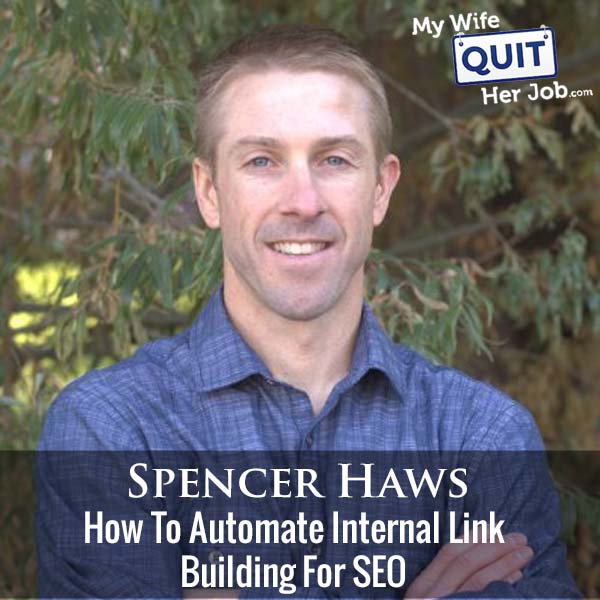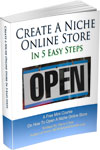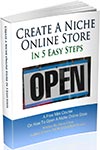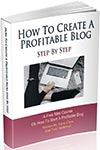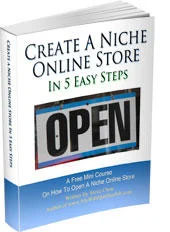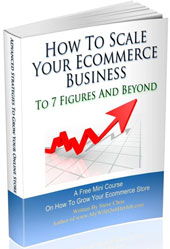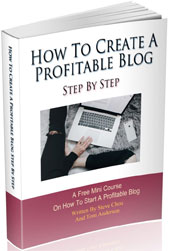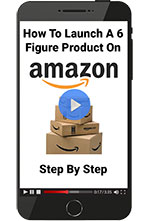Podcast: Download (Duration: 44:46 — 51.5MB)
Today I’m thrilled to have Spencer Haws back on the show. Spencer runs the popular blog NichePursuits.com where he teaches others how to start niche online businesses.
He’s also the creator of Long Tail Pro. He’s sold on Amazon FBA, created plugins, software, affiliate sites, you name it! In this episode, we talk about Spencer’s latest venture and how you can quickly improve your search rankings.
Get My Free Mini Course On How To Start A Successful Ecommerce Store
If you are interested in starting an ecommerce business, I put together a comprehensive package of resources that will help you launch your own online store from complete scratch. Be sure to grab it before you leave!
What You’ll Learn
- Why Spencer exited his physical products business
- How Spencer makes money today
- What’s new with search engine optimization
- Why internal backlinking is important
Other Resources And Books
Sponsors
Postscript.io – Postscript.io is the SMS marketing platform that I personally use for my ecommerce store. Postscript specializes in ecommerce and is by far the simplest and easiest text message marketing platform that I’ve used and it’s reasonably priced. Click here and try Postscript for FREE.
Klaviyo.com – Klaviyo is the email marketing platform that I personally use for my ecommerce store. Created specifically for ecommerce, it is the best email marketing provider that I’ve used to date. Click here and try Klaviyo for FREE.
EmergeCounsel.com – EmergeCounsel is the service I use for trademarks and to get advice on any issue related to intellectual property protection. Click here and get $100 OFF by mentioning the My Wife Quit Her Job podcast.
Transcript
You’re listening to the My Wife Quit Her Job podcast, the place where I bring on successful bootstrap business owners and dig deep into what strategies they use to grow their businesses. Today I my good friend Spencer Haas on the show and Spencer has been on the podcast a couple of times in the past, but today we’re going to be talking about an SEO tactic that I personally have not been doing a good job with and how Spencer has helped me fix these problems. But before we begin, I want to thank Klaviyo for sponsoring this episode. Now it’s safe to say that most of us have been doing a lot more online shopping lately.
00:29
And if you’re an e-commerce brand, means you might be seeing more first-time customers. But once they’ve made that first purchase, how do you keep them coming back? That is what Klaviyo is for. Klaviyo is the ultimate email and SMS marketing platform for e-commerce brands, and they give you the tools to build your contact list, send memorable emails, automate key messages, and more. A lot more. And that’s why over 30,000 e-commerce brands like Chubbies, Brooklinen, and Living Proof use Klaviyo to build a loyal following.
00:55
Strong customer relationships mean more repeat sales, enthusiastic word of mouth, and less depending on third party ads. So whether you’re launching a new business or taking your brand to the next level, Klaviyo can help you get growing faster and it is free to get started. So visit klaviyo.com slash mywife to create your free account. That’s K-L-A-V-I-Y-O dot com slash mywife. I also want to thank Postscript.io for sponsoring this episode. Now, if you run an e-commerce business of any kind, you know how important it is to own your own customer contact list.
01:24
And this is why I’m focusing a significant amount of my efforts on SMS marketing. I sincerely believe that SMS or text message marketing is going to be a huge channel for my store going forward. And I’ve chosen Postscript.io to be my text provider. Now why Postscript? It’s because they specialize in e-commerce stores and e-commerce is their primary focus. Not only is it easy to use, but you can quickly segment your audience based on your exact sales data and implement automated flows like an abandoned cart at a push of a button.
01:51
Not only that, but it’s priced well too and you only pay for the messages that you actually send. So head on over to postscript.io slash Steve and try it for free. That’s P O S T S C R I P T dot IO slash Steve. Now onto the show. Welcome to the My Wife, Quit Her Job podcast, where we’ll teach you how to create a business that suits your lifestyle so you can spend more time with your family and focus on doing the things that you love. Here’s your host, Steve Chu.
02:23
Welcome to the My Wife Quitter Job podcast. Today I’m thrilled to have Spencer Haas back on the show after a long hiatus. Now, in fact, the last time Spencer was on was back in episode 136. And if you don’t remember who Spencer is, he runs the popular blog, Niche Pursuits, where he teaches others how to start niche online businesses. And what I like about Spencer is that he started a bunch of completely different businesses. He’s the creator of Long Tail Pro. He’s done Amazon FBA, plugin software, affiliate sites, you name it. And
02:51
Recently, he started reviewing books just through photos of his facial expressions. All that and he’s also a family man with four kids. So welcome back to the show, Spencer. How are doing today, Thanks, Steve. It’s great to be back. I appreciate you. That’s my new idea, the facial expression book review. I hadn’t revealed that publicly, but… Well, you did when you posted on Facebook. I did post it on Facebook to my friends. So we’ll see where that goes.
03:20
But other than that, I’m doing great. Business is going well. I’m super excited to be back on the podcast. I always love chatting with you. Awesome. So I think the last time we spoke, which was a little over two years ago, you had just sold Long Tail Pro. What have you been up to since then? Yeah, quite a bit. So yeah, I’ve been on a journey. It’s been almost four years now, basically four years since I sold Long Tail Pro. Oh, has it been? Okay. So maybe it’s been even longer since you’ve been on.
03:46
Yeah, I don’t know. So it was early 2016 is when I sold Long Tail Pro. Oh man. And yeah, time flies. so since that time, you know, I’ve still always had a portfolio of niche sites. So I’ve always continued to work on that. And as you mentioned in the intro, I’ve had an Amazon FBA business. So I worked on that for a couple more years, but it was early 2018 that I basically exited that business completely. I sold my Amazon FBA business as well.
04:16
And so since 2018, I’ve now dabbled in a couple of software projects, started a couple of WordPress plugins and the one that I’m really focusing on and trying to grow now is Link Whisper. We can talk about a little bit more, but yeah, kind of done a few different things since, you know, still niche websites, definitely working on my blog and then software development. I’m curious, why did you exit your physical products business?
04:43
I was really trying to eliminate distractions. I do have, whether it’s good or bad, I tend to focus on a lot of different things. Or I should say I don’t focus on any one thing a lot of times. so I’ve got, you know, at the time I had seven or eight niche websites that I was trying to run. had several products on Amazon that I was selling. I was starting to dabble again in doing software development.
05:10
and I was just looking at my schedule and it’s like, I’m spending like 30 minutes on each of these and not really giving any of them the attention that they deserve. And so I just took a long hard look at it and decided, you know what, I think I want to get out of Amazon so I can focus on software. Just because I had been so successful in the software business with Long Tail Pro, Amazon was great and I did well and had a nice exit there, but I felt like my future should go back to software.
05:40
And so I started selling, not only did I sell my Amazon FBA business, I actually sold a few of my niche websites and I’ve kind of pared it down to two or three at this point that I really focus on. Oh, wow. So you’re actually kind of unique in that you’ve done so many different things. And when you evaluated what to sell and what to keep, can you just kind of comment on the dialogue in your head, what the pros and cons of each were? Yeah, absolutely. So yeah, really
06:08
deciding what to keep and whatnot. One, I mean, very easily is to decide which one is the most successful. But even bigger for me is which one do I think has the most potential for success. And so when I looked at the websites that I owned, that one was fairly easy. I could see which websites are doing well and which ones aren’t and which one I felt like had the most growth potential. So I sold off the really small ones that
06:36
either weren’t doing well or I felt like would just take a monumental amount of effort to get to a much larger level. So I sold those off. Same story for Amazon. I had done really well and actually at the time it was my largest revenue generator. I had sold Long Tail Pro, which had been my biggest business. And then I had my Amazon business, which was doing really well. But I just felt like
07:03
There was so many new competitors coming into the market. I didn’t have, you know, a patented product that was super defensible. And I could just see that it was going to be a grind to keep my existing revenue levels where they were and to grow significantly. And I just felt like I was pulled in a different direction and maybe even had more interest in a different direction. And so I decided to sell. you didn’t have a niche site alongside of your Amazon product. It was just purely Amazon revenue.
07:33
I did have a niche site along one line of my products. I had several products that I had thrown up on the marketplace to see how they would do. I’ll just tell everybody, I was selling pillows. I sold pillows and that was my line of pillows that was doing very well. I did have a niche site in the sleep pillow space. I sold that as a package when I sold my business.
08:02
So today, what are your primary revenue drivers? So I have, like I said, two or three niche websites that I’m focusing on. One is a public case study that I built. started almost two years ago at this point in front of my niche pursuits audience that it’s owntheyard.com. It’s a backyard niche website. So backyard games, backyards, landscaping, that sort of thing. And it’s doing pretty well. Nice.
08:30
And a couple other sites that I focus on, then I’ve got nichepursuits.com that I do continue of course to earn money there. And now Link Whisper is, so Link Whisper and Niche Pursuits together really are my largest revenue generators. Cool. I mean, obviously niche sites are still viable, but how has that area of the business evolved? Cause I remember, like I followed you for a long time and at one point you had a ton of niche sites.
08:57
Can you just comment on how that whole landscape has evolved over time? Yeah, there has been a ton of evolution. So 10 years ago was right before I quit my full-time job. I quit my job in 2011. And my goal and focus was just to build a site to where it was making about $100 a month. Right. And I felt like if I could do that and just replicate the process 100 times, I’d be making $10,000 a month, which was great money.
09:27
And so that’s what I did. I built over a hundred niche sites. you know, so I was eclipsing that $10,000 a month mark. And at the time that worked well because I could just get the exact match domain, right? Maybe five to 10 articles on one site that were targeting, you know, just very specific phrases and try to rank in Google for these long tail keywords. And I was happy with that making a hundred dollars or $200 a month.
09:56
And it was very easy to do that. If you targeted the long-tail phrases and you had the exact match domain and even built just one or two links like you would rank, it was much easier back then. But Google has evolved quite a bit and they have sort of devalued the exact match domains. At least you don’t get a big boost for having that anymore. You need to write much more in-depth content and the more authoritative your site is overall, you tend to rank better across the spectrum.
10:25
of the articles on your site, so it just doesn’t make sense anymore to try and build 100 sites. It makes a lot more sense to build one site that has hundreds of articles, so you can have a really authoritative site. So yeah, over the years, I’ve slowly gone from, I’m gonna just crank out five or 10 sites as quickly as possible to, I need to get rid of all these sites in my portfolio and just focus on the few that I really feel can grow much larger.
10:53
Yeah. And is that kind of how Link Whisper kind of came about? Why don’t you explain to the audience what the plugin does first and how you came up with the idea. Yeah. So Link Whisper is an internal linking plugin. So it makes it much faster and easier to build internal links between your articles. And it either automates the process if you want, or just suggests really smart internal links that you can just check a box and it will add.
11:22
those links either to or from particular articles. People can check it out if they want, but it’s really powerful. And the reason I built it was to optimize my own site. So I had a few sites that started to have a couple hundred articles on them and it can become quite a large task to think about what related content do I have to my existing articles? I know I need to be building internal links, but it becomes a very manual process if you just have to do it yourself. And so I thought,
11:51
you know, there’s gotta be a way we can semi-automate this process and save a ton of time. And so that’s exactly what I did is I went to a developer and just explained, you know, my idea of really the of the idea was initially, as you write content, it would be great if link suggestions were appearing below sort of the draft of your article, and you could just check a box as you went to add those links to your content. And so that’s what I built initially and it’s expanded.
12:20
you know, quite a bit from there now with reporting and other features as well that just make it much faster for internal links. But it definitely came from my own need building my own sites. You know, that’s where I came up with the idea. And I’m just kind of curious since you’ve just kind of gone through this journey just on developing a WordPress plugin, how does that work exactly? Can anyone just create their own plugin? And do you have to jump through any hoops just to get your plugin on the WordPress? I guess the WordPress site, the official one.
12:51
Yeah, so two parts to that question. One, can anybody develop it? Sure. You know, if they have money to hire a developer or they’re a developer themselves, they can build and write the code and you can install plugins that are not on the WordPress repository, right? So you can just have a third party plugin that you can build and install yourself. Link Whisper is on the official WordPress repository. And there are a few hoops that you got to definitely jump through.
13:21
Their team goes through and they verify the code to make sure it’s safe and isn’t malicious in any way, isn’t broken, right? And so they do actually go through and verify all of that before your plugin gets approved. And so we went through that process and it can take actually not too long. They’re pretty quick. I was surprised how fast they were, but I think it was two or three weeks and then you get listed on the WordPress repository. it cost money or? Nope. Completely free to get it listed there.
13:51
And it just comes down to you how you want to market it and gain exposure. Okay. And before we kind of get into the nuts and bolts of SEO, I’m just kind of curious myself, what is the difference between creating a WordPress plugin versus creating a standalone software product, which is what Long Tail Pro was. Can you just kind of comment on why you made one decision versus the other way back in the day? Yeah.
14:14
Yeah, so standalone software, obviously any website can use it. Either it can be a SaaS or it can be a downloadable product, but it doesn’t matter what platform your product is on, right? It’s a piece of software that kind of works independently on its own and can be run anywhere. A WordPress plugin can only work on WordPress sites. You actually install it on your WordPress dashboard and it can interact a little bit better.
14:44
with your WordPress site than perhaps a standalone piece of software. And so in this particular case, the reason I went with a plugin is just the way that Link Whisper in this case interacts with your site and actually building links on your WordPress site. It made a lot of sense to do a plugin. And just from a development standpoint, it’s a lot easier if somebody’s actually installed this code on their website, it becomes much easier to interact and build the links.
15:14
do full reporting and et cetera. So that’s why I went with a plugin in this particular case. long tail, in the days of long tail pro, could you have done the same thing? WordPress plugin versus standalone application like you did? That’s a good question. It would have functioned quite a bit differently. And I imagine it would have only made sense to make long tail pro a plugin if it was interacting more with the individual website and just
15:42
I’m thinking that if it sort of pulled all the keywords that were being targeted on your website or did more suggestions based on your actual site, it could have worked in that particular way. But just the way the Long Tail Pro was developed and the original idea made sense as sort of a standalone piece of software because you might have 10 websites, right? And you want to do keyword research on all 10 of them.
16:09
And so it might make sense just to have it independent of any individual site. For the people out there who are listening to this and want to create perhaps their own software product, do you have like a process for finding a developer?
16:23
Yeah, you know, I do. I wish I could say I had a better, you know, standard process. You know, I, the, two ways that I found developers is on freelance job websites. So Upwork or others. And I find that it’s very important to go through a particular vetting process. I usually, my, my quick tip here is I usually like to post my job and my description of what the software idea is.
16:53
And then I like to ask the question, what problems do you foresee with this particular software product or what ways would you improve? What would you improve the software idea? Not necessarily new features, but what I’m looking for from a developer is can they think of problems or solutions that I haven’t thought of on my own? And if they’re able to do that and think through, okay, here’s the idea.
17:23
They haven’t thought about, it’s not gonna work on these types of websites, or it’s not gonna work because of this technical reason. Those are the types of people that I wanna hire because they’ve thought of something that I didn’t on my own, right? And it’s a way to certainly narrow down the talent pool relatively quickly because most people will come back and say, no, I don’t see any problems. But the one or two that come and say, hey, you didn’t think about this, this, and this, those are the ones that I wanna…
17:53
potentially higher and get to know a little bit better. So Upwork is one place and then either just basically referrals, talking to other people that I know, do they know any good WordPress developers, et cetera? You can often get really good referrals that way. Interesting that you post the exact idea for your plugin. So you’re not afraid that they’ll steal it and sell it as their own? No, I’m not. I’ve never had that concern. And luckily so far that’s never been an issue.
18:22
Did you leverage your software team from Long Tail Pro at all or are these just completely new developers that you found? So initially it was completely new developers and the initial version was developed with somebody I’d never worked with before. But about halfway through I did actually contact my old team at Long Tail Pro. One developer that I’d worked with before had the PHP experience that he could help out with on Link Whisper.
18:49
I now have two developers, one that was helped a tiny bit on Long Tail Pro and then the other one was unrelated. Okay, cool. Yeah. So let’s shift gears a little bit and talk about SEO and what this plugin does. So you mentioned before you had a bunch of niche sites and you found the need to interlink articles within each article. Can you kind of just talk about the benefits of doing this from an SEO perspective? Like, do you have any case studies?
19:18
on that kind of show that this actually will improve the rankings and traffic for a post? Yeah, definitely. I do have some case studies, but just generally Google values links. That’s what their search engine is based on. A link is a vote to that particular page that helps Google know, this is important. It should be ranked higher. And usually we just think about external links. So if you get an external link from a powerful website, that’s going to help your page rank better. But your own website,
19:48
also has authority. And so if you build an internal link from one page to another on your own website, that actually is a vote as well in Google’s eyes and can indeed help your site rank better. And so Google has explained this. It’s pretty well known in the SEO community that internal links do indeed help as well. But as far as case studies, I do have a couple of articles on intrapursuits.com that people can check out if they want.
20:17
One of those is for my site, OwnTheYard.com, where I had already written several articles and then I decided I’m going to do nothing else except go back and build internal links to, I don’t remember the exact number, but it was something like 30 articles and I’m going to see what happens over the next month or two months, I think is what I actually ended up tracking.
20:44
And what I found is that those articles that received internal links increased ranking significantly. So I’m just pulling up a chart here. And a little over 75 % of those articles improved rankings in Google. And some of them went from ranking on the third or fourth or lower page of Google to actually in the top three of Google, just by building three or four internal links.
21:11
A lot of those were longer tail keywords, of course, that were easy to rank, but just on their own, they weren’t really ranking very well, and then a few internal links really bumped them up. Anyways, quite a few other really great results by using Link Whisper. The one thing that I always tell people is that if you do nothing else to optimize your articles, if you have an article that has zero internal links pointing to it, just building one or two can
21:42
often have quite a large impact because you’re basically going from no links at all and Google doesn’t really know if that article is important to even just a couple of votes and Google goes, okay, let’s notice this article. It does look like it’s valuable, it’s well-written content. Let’s go ahead and rank this much better. And so, yeah, that’s kind of a quick rundown of why you would use Link Whisper. So when it comes to internal linking,
22:12
Do you have to prioritize or do you just go for kind of interlinking with all of your articles? Like what’s the strategy here? Like if you already have an established blog and you already have pages that are kind of ranking that you want to rank higher, would you just focus your internal link building on that post or do you believe that every article on your site should be kind of interlinked in some way? I do believe that every…
22:38
I do believe that every article that you’re trying to rank better in Google for should have internal links. I add that caveat because there are a lot of blog posts, either news articles or just quick updates or maybe it’s of a viral nature that you don’t actually intend to ever rank in Google. If you have a bunch of articles, I know there’s a lot of news websites that they have thousands of articles that they’re actually not trying to
23:05
really rank in Google for. You might not build internal links to those. But all articles that you’re hoping to rank organically in Google for should have some internal links. And the way that you might prioritize those are ones that are already getting some organic traffic that are maybe at the bottom of page one or at the top of page two. Those would be good ones to look at. Or those articles that have zero internal links, like I said. So if you have an article that’s already got five or six internal links,
23:34
and it’s still ranking, you know, on page 100 or whatever. Like maybe that’s not one that you would prioritize because you’ve already kind of built a few and it’s not working. So that would be my thoughts on that.
23:50
If you sell on Amazon or run any online business for that matter, you’re going to need a trademark to protect your intellectual property. Not only that, but a trademark is absolutely necessary to register your brand on Amazon. Now I used to think that any old trademark registration service would work and I could even try to register my own trademark by myself on the cheap, but I was dead wrong. Securing a trademark without a strategy in place usually results in either an outright rejection or a worthless, unenforceable trademark.
24:18
Now that is why I work with Steven Weigler and his team from Emerge Council. They have a package service called Total TM, which provides the same attention to detail and process that large law firms do at a fraction of the price. Now for me personally, I like Emerge Council because of their philosophy. Their goal is to maximize IP protection while minimizing the price. So before you decide to register a trademark by yourself or file for other IP protection, such as a copyright or a patent, check out Emerge Council first and get a free consult.
24:48
For more information, go to emerge council.com and click on the Amazon sellers button and tell Steve that Steve sent you to receive a hundred dollar discount on the total TM package for Amazon sellers. Once again, that’s emerge council.com over at EMERGECOUNSEL.com. back to the show. Interesting. So the, your process would be to find the posts in order of priority that perhaps are ranking in Google.
25:17
or that you want to increase rankings for, and then just focus all of your efforts on building internal links there as opposed to just any old article on your site. Right. Yep. I would definitely start there. And then of course, you you can expand from there if you want to build a few more and get a more aggressive with some of those, but definitely focus on sort of those top tier articles or those with the most potential. So those ones that you want to rank for, would you outlink, outbound link from those posts?
25:46
Cause I guess in theory, you’re passing along link juice wherever you’re linking to in theory, right? So for those ones that are already ranking that you want to rank, would you not outbound link from those posts to other internal posts on your blog?
26:01
I still do, but you might want to limit yourself a little bit in terms of you don’t want to just go crazy with it. But if it still makes a lot of sense to send people to a relevant article, I would still do that. That might be three or four outbound internal links from those articles as opposed to 10 or 20. If you’re really trying to focus the link juice, if you will.
26:29
on that one particular article, it does make sense to kind of concentrate a little bit in that regard. Okay. And how big of a deal is Anchor Text when it comes to internal linking? It’s a pretty big deal. the reason, well, one is that most people know, at least in the SEO community, that the Anchor Text does tell Google the types of keywords that you’re hoping to rank for. Google is a machine. When they read
26:57
a link and it says best survival knife as the anchor text, that does give a little added weight for that term best survival knife as opposed to just click here. That is pretty well known but you can get in trouble if you build all your external links from other websites if you’re out building links and 100 % of your links say best survival knife, Google might penalize you because that’s very unnatural.
27:25
They’ve sort of specified in their SEO guidelines that internal links are a little bit different. They’re not going to penalize you for using the same anchor text over and over again because it’s your own website. And if that truly is the most relevant anchor text, you can do that. So the bottom line is you can get away with adding more keyword rich anchor text with internal links than you could with external links. And so that can help you get a little bit of a boost.
27:55
in Google as well. do you recommend using a keyword tool and just making all of your internal linking using keyword phrases that people are actually searching for? For the most part, yes. If you can do that, that would be a smart strategy. Sometimes that can be hard to do, you know, but if you can get at least a phrase that’s close, that would be ideal. Okay. And then even if it means rewriting that sentence a little bit, you would
28:24
try to get that in there? yeah, I would. If it makes sense, do it. If you can’t, you know, if you don’t want to rewrite every sentence, a link is better than no link. So it’s gonna be hard to kind of do a tutorial via a podcast since there’s no visual component to it. But let’s say you have a blog that has, you know, several hundred posts, and I actually just installed your plugin, and I started using it in the last couple days.
28:52
What is your process if you had several hundred articles and you’re using this tool for the first time? where would you start with the internal link building process? Right. So if I’ve got a bunch of existing articles with Link Whisper, you can go to a report section and you can see your link reports and you can sort your articles by those that have the most internal links or the least internal links. And I would start
29:20
with those articles that have no internal links built to them, right? And then I would start building links there. What I might do to, if you’ve still got a ton of articles that have zero internal links, I might go ahead and cross reference over with my either Google Analytics or Google Search Console to figure out which articles are either kind of ranking where I said, you know, at the bottom of page one or the top of page two, or getting decent organic traffic, because this is going to be
29:50
quick win. If it’s already getting good organic traffic and it has no internal links, you absolutely want to go into Link Whisper, find that and then start building some internal links. Is that the next feature of the tool? I didn’t see that there. Link Whisper does not link up with your Google Analytics at this point, but it is kind of on the back burner of potential. Okay. We may get there at some point. Okay. Step one, figure out which posts have traffic and if they have no internal links, start building some internal links to them.
30:19
And then I just want a clarification here. If you have a post that has no internal links, but your intention really isn’t to rank it per se. So for example, I have a bunch of podcasts on my, on my blog and in general, those podcasts episodes don’t really rank. So I wouldn’t want to build internal links to those necessarily. that accurate? Correct. Yep. That’s, that’s a great example of maybe an article. Yeah. I just, I wouldn’t build any internal links to them, but you could go in and build an internal links from those podcasts.
30:48
to the articles you actually are trying to rank for. Got it. Okay. All right. What’s the next step after that? Yeah. So, um, so the process again, just to clarify for people, you know, you can go into the reports and then you just click, you know, if you find that you have a particular article that has no internal links, you just click the add button and link whisper will scan your entire site. And within a few seconds, it’s going to suggest to, know, it could be 10 or 20 articles that you could build internal links from.
31:17
to that particular article and all you do is check the boxes next to the ones you want and click done. It’s already got the anchor text selected for you or you can edit that or adjust it if you want. So really within a minute or two, you can build 5, 10 internal links really, really quick. Do you have any guidelines on the number? There is no necessarily strict guidelines, but Google has sort of said at least some of the representatives like Matt Cutts back in the day said that if you have
31:47
over 100 internal links coming from or to any particular, actually that was only coming from any article that might be too many. So there’s really no max amount of internal links you could build to a particular article. Okay. Right. Yeah. So basically you’re just telling Google which posts on your site had the highest priority essentially, right? Right. Okay. Right. Are the most important. And so that can be a whole process, right? So first start with the ones that have zero internal links.
32:16
then you might want to focus your articles in sort of a topical cluster. So without going into too much depth, you know, if you have a core topic, I’m just trying to think of an example here on the top of my head. E-commerce? I don’t know. Right. So yeah. So if you have your core topic is how to get started on, you know, selling e-commerce, right? Like that’s a pillar article that you got.
32:44
And then you’ve got all these spoke articles, if you will, like how to sell on Amazon, how to use Shopify, Shopify review, right? These are all kind of spokes off of how to get started starting an e-commerce business, right? You might wanna look at making sure that all of those articles are linking to and from each other, right? So you would come into your, what you would do in that case is you’d go to your how to sell or how to get started with e-commerce, that’s your core article.
33:13
You’d go in there, like you’re editing that article, and then you’d look at the suggested links from Link Whisper. And hopefully it’s suggesting that you link to that Shopify, to that Amazon, to those other spoke articles. And you can make sure that you’ve got that internal linking structure to those related articles. That’s kind what I would do next with your most important pillar articles. Make sure you’ve got that linking to and from.
33:41
And then I would go into that Shopify, that Amazon, make sure there’s a link pointing back to that original pillar article as well. Can you just, for the, for the people who are listening to this, who aren’t familiar with that model, can you just kind of give, give a brief overview on the hub and spoke model in general and, and whether it works and comment on it? Yep, So yeah, the kind of the hub and spoke model is really, you’re trying to tell Google that you’re a topical authority on this particular subject and Google, um,
34:09
not only reads the article, right, but they look at all the related content on your site and they can see, you know, if Steve has just one article on e-commerce and no other articles on his entire site, like maybe he’s not truly an e-commerce expert, but if he’s got, you know, 50 or, you know, at least 10 tightly related articles, all similar and they’re linking to each other, this kind of
34:37
helps Google understand he’s using all these latent semantic keywords. He’s got more in depth on these related phrases. And if they’re all linking to each other, that helps Google truly know that, Steve really is an authority on e-commerce sites. And so we should probably rank this core article a little bit better. Nice. Well explained, Spencer. I love how you break things down into simpler terms. Thank you. OK, so after that, so we’re building a bunch of hub and spokes. Any other tips for internal link building?
35:06
boy, there’s a lot that you can do. The key is just making sure that you are linking to all your articles that you’re trying to rank for. And then just, would make it part of your process, whether it’s you writing your articles or if you have authors or editors, to building links from any new content that you have to other articles on your website. So make sure that whether that’s in your instructions, say, okay, build three or four internal links from every article that you write.
35:34
And again, you can use Link Whisper to do that. I would just make it part of your process. And as long as you do that, you’ll always have, you know, new internal links being built down the road. Yeah. I mean, I know for myself, like I always start out with great intentions, but then I forget to do things after the fact. And so that’s why I’ve actually liked your plugin just for that aspect. It just makes it a lot easier to create these hub and spokes really quickly. Wanted to switch gears a little bit. You know, I feel like Google has been releasing some sort of big update every month.
36:03
at least this year. What would you say are kind of like the most important factors just for SEO in general today in your eyes?
36:12
You know, a lot of it really just comes down to the core concepts that have been there for a long time, but they become more more refined, right? Like there’s been a lot of people like me that back in the day, you know, I was trying to kind of game the system in that, you know, I wanted an exact match domain because that gave me a boost. And maybe I didn’t worry as much about the quality of content. knew content was important, but Google has always improved and made all of us evolve a little bit. So it comes down to a few core concepts.
36:44
One is quality content. You’ve got to have quality content and related to that is you have to be targeting specific phrases. You can write a great article that everyone loves to read, but if it’s not targeting a very specific phrase that people are actually searching for, you’re not going to rank for anything and Google’s just not going to be able to send any traffic. You kind of have to tell Google,
37:10
I want to rank for this long tail key phrase. So as far as using keywords, keywords in the title is still really important. Using the keyword a few times throughout your article is important. But then what’s become even more important is using sort of those related keywords throughout your article so that Google knows you have a little bit more depth in your content. so keywords, content, always still super, super important. External links.
37:39
Still, that is the backbone of Google. And so if you can get a few external links to your site or your individual articles, that’s gonna be great. And natural links are always better than other types of links. And certainly spammy links have become more more devalued over time. And that’s been a lot of the updates that Google has done, even still recently, is kind of devaluing spammy links or other types of links that really shouldn’t be passing link juice anyways.
38:09
And then related to that, of course, is internal links, which you have full control over. So it’s a few things. It sounds simple, right? But there’s a lot of individual steps to making sure you’re doing the best job you can. But that really is an overview of SEO. Have you ever used a disavow tool ever? I have used it. And I don’t know if I needed to, honestly, at this point. I kind of think that Google has gotten smarter and smarter.
38:37
One of my sites about a year ago was just getting so many automated spammy links and I was just so nervous about it. I just went in and I disavowed all those links. you know if it did anything or? I really don’t know because I hadn’t received a penalty, right? But I was worried I was going to and so was like, I’m going to be proactive on this one. And in particular, because it was for my public case study site, this own the yard.com that I built. I was like, really like got attacked too, right?
39:07
very likely was. Yep. And I was super worried I was going to get penalized. So I decided to go ahead and do it. So nothing bad happened to my site, fortunately. So whether or not the disavow tool did that, I don’t know. Okay. And then what do you got going on in the future? You always have like a bunch of projects going on at the same time. So I’m always just kind of curious what you’re up to. Well, you already mentioned my facial review of books.
39:33
So I may parlay that into a full-grown business, other than that, not a lot actually. I’m really trying and you’re absolutely right that in the past I’ve tried a lot of different things and had several pans on the fire, but I’m trying to scale that back. I’ve sold off my Amazon FBA business, sold off several niche sites. I’m really just going to focus on Link Whisper for now and my
40:02
couple other sites that I have. at least I’m really trying to focus on just those. So what the future brings, I don’t know, I don’t have anything else new that I have planned right now. And hopefully I can keep it that way for a little bit. Did you want to talk about the Shopify version of this also and how it pertains to ecommerce? No, it’s not out yet, right? But just kind of curious what you got planned for that. Yeah, so I do have a Shopify version of Link Whisper in the works. So I
40:30
Again, this is one that I wouldn’t have thought of necessarily on my own, but my audience sort of reached out to me and said, Hey, like, this work on Shopify or do you ever plan to do that? And I didn’t. And I got several people saying, Hey, we’d love it if you had it on Shopify. There’s not a lot of great SEO tools on Shopify. So yeah, over the last few months, we’ve been developing a Shopify version that will work very similarly to the WordPress version, but it will be on the Shopify app store, you know, on
41:00
the Shopify platform there that you can log into your store and use it right there. It’s currently in beta testing and I’m hoping in the next month it will be live and we can launch that and start getting some customers on Shopify. And again, it’s the same principle, right? You want to show Google which products on your site that you’re prioritizing essentially, right? Yeah, either products or if people are blogging a lot on the Shopify platform, it’ll work great on the Shopify blog.
41:29
But certainly you can point a lot of internal links, like from your blog to individual products that you want to get some SEO traffic for, or just the people reading your blog, clicking over to your products. It’ll make it a lot easier to add those links. Cool, awesome. So Spence, where can people find you, your tool, and if they want to check out your facial expression book reviews, where can they find you?
41:55
People can follow along with what I’m doing over at niche pursuits.com. That’s still my blog there. And if I ever do go full time on the facial reviews, that’s where I’ll announce that so they can follow along that. But linkwisper.com is where people can go and check out the plugin. I’ve got demo videos that they can look at and see it in action. And feel free to reach out with me. I’ve got a contact form on niche pursuits.com. If they want to shoot me an email, I’m happy to respond.
42:25
connect with them. Yeah, and I’ll probably post some sort of case study. Like I said, I’ve been using the tool for like the past week and you know, it takes time to see the effects of this. So maybe three or four months down the line, I’ll, post like a case study of my own. Yeah. Yeah. That would be great. I, I’m glad you’re using it and would love to have your audience check it out. Awesome. Well, Spence, thanks a lot for coming back on the show. I guess it’s been just way too long since I’m pretty sure the last time I had you was after the sale of long tail pro and man, four years ago, time flies.
42:55
Yeah, it does go quick. It’s like, I know we stay in touch and we see each other. But yeah, actually be on the podcast. It’s great to be back. Well, hope to have you back sooner than I guess, three years from now. Sounds good. Take care.
43:13
Hope you enjoyed that episode. Now as we mentioned in the episode, Spencer is giving $25 off lifetime for Link Whisper to all My Wife Quitter Job listeners, so if you’re interested in the tool, use coupon code Steve to get $25 off lifetime. Now this code expires August 15th. For more information about this episode, go to mywifequitterjob.com slash episode 316. And once again, I want to thank Postscript.io, which is my SMS marketing platform of choice for e-commerce.
43:39
With a few clicks of a button, you can easily segment and send targeted text messages to your client base, and SMS is the next big own marketing platform, and you can sign up for free over at postscript.io slash Steve. That’s P-O-S-T-S-C-R-I-P-T dot I-O slash Steve. I also want to thank Clavio, which is my email marketing platform of choice for e-commerce merchants. You can easily put together automated flows like an abandon card sequence, a post purchase flow, a win back campaign, basically all these sequences that will make you money on autopilot.
44:07
So head on over to mywifequitterjob.com slash K-L-A-V-I-Y-O. Once again, that’s mywifequitterjob.com slash K-L-A-V-I-Y-O. Now I talk about how I use all these tools on my blog, and if you are interested in starting your own eCommerce store, head on over to mywifequitterjob.com and sign up for my free six day mini course. Just type in your email and I’ll send you the course right away. Thanks for listening.
44:29
Thanks for listening to the My Wife, Quit Her Job podcast, where we are giving the courage people need to start their own online business. For more information, visit Steve’s blog at www.mywifequitterjob.com.
I Need Your Help
If you enjoyed listening to this podcast, then please support me with a review on Apple Podcasts. It's easy and takes 1 minute! Just click here to head to Apple Podcasts and leave an honest rating and review of the podcast. Every review helps!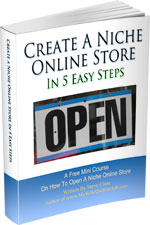
Ready To Get Serious About Starting An Online Business?
If you are really considering starting your own online business, then you have to check out my free mini course on How To Create A Niche Online Store In 5 Easy Steps.
In this 6 day mini course, I reveal the steps that my wife and I took to earn 100 thousand dollars in the span of just a year. Best of all, it's absolutely free!


